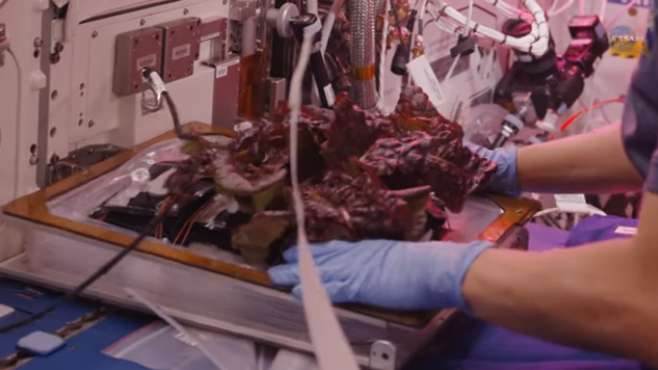Space gardening

Roman Statesman Marcus Tullius Cicero said, "If you have a garden and a library, you have everything you need."
Humans attempting someday to make Mars their home may well share the sentiments expressed by the orator from ancient Rome. As for the library – books can now be stored digitally. But how does your garden grow in space?
To find out, scientists have been studying plant growth on the International Space Station (ISS). The results could help boost the productivity of both extraterrestrial and earthly gardens.
Recently, the ISS has been home to some impressive harvests, yielding tasty snacks for crewmembers! However, scientists aren't through trying to unlock the secrets of how plants grow away from home.
"Future space outpost dwellers will need to grow plants for food and for recycling air and water," says Anna-Lisa Paul of the University of Florida. "So we're studying how plants adapt to the spaceflight environment. Our findings will also help us understand how plants might respond to new and challenging environments here on Earth."
Paul and her colleague Robert Ferl have been growing plants in space since 1999, when they launched their first experiment on Space Shuttle Columbia. Several space station experiments followed. One of their most compelling discoveries was that certain root growth strategies assumed to require gravity really don't.
Plant roots seek water and nutrients by growing away from where they're planted. To determine which direction to grow, terrestrial plants use gravity as a cue. And they use touch to maneuver around obstacles. In the late 1800's, Charles Darwin demonstrated that plants growing along a tilted surface don't send their roots directly away from the seed but instead send them to the right or left. He hypothesized that this growth pattern—called "skewing" – was caused by a combination of the roots touching their way across the slanted surface and gravity pulling straight down on them.
In an experiment in 2010, Paul and Ferl discovered, however, that roots of plants growing in microgravity on the station, skewed like their earthly counterparts.
"The ISS showed us something we never would have known otherwise," notes Paul. "Gravity isn't essential in root orientation."
Good news. That's one less impediment to growing plants in space. Plants will efficiently seek the nutrients they need without gravity as a cue.
The experiment also studied the patterns of genetic expression. Space plants changed the way they expressed their genes in order to produce specific proteins helpful in zero gravity.
Paul explains, "When living organisms are faced with environmental change, their response almost always involves a change in genetic expression. To cope, they 'switch on and off' certain genes."
Plants are pros at this.
Paul says, "Plants cell walls undergo a kind of remodeling in space. The genes associated with the cell wall are often in the opposite 'switch positions' than they're in on Earth."
The researchers aren't yet sure what purpose this serves, but they intend to find out with additional experiments.
Paul and Ferl aren't alone. Many other scientists have also been studying plant growth on the space station to unlock the secrets of successfully growing plants in this novel environment. At the heart of all of the research is the quest to provide humans with 'everything' they need, wherever they may be.
Provided by NASA





















